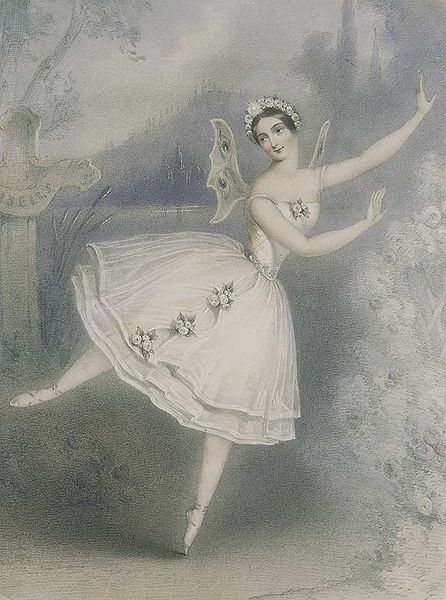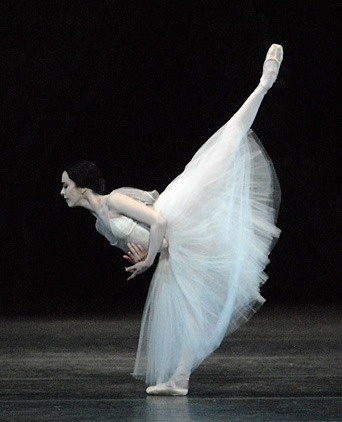GISELLE
1 sayfadaki 1 sayfası
 GISELLE
GISELLE

Carlotta Grisi Giselle gibi (1841)
Koreografi: Jean Coralli & Jules Perrot , Marius Petipa (uyanış)
Beste: Adolphe Adam
İlk oynanışı: 28 Haziran 1841 Paris
Original ballet company Ballet du Théâtre de l'Académie Royale de Musique Bale du Théâtre de l'Académie Royale de Musique
Karakterler Giselle, Albrect, Hilarion , Bathilda
Myrtha, Queen of the Wilis Myrtha, Wilis Kraliçe için yaratılmıştır
Carlotta Grisi ve Lucien Petipa
Tür: Romantik Klasik bale
Giselle, ou Les Wilis is a ballet in two acts with a libretto by Jules-Henri Vernoy de Saint-Georges and Théophile Gautier, music by Adolphe Adam, and choreography by Jean Coralli and Jules Perrot. The librettist took his inspiration from a poem by Heinrich Heine. The ballet tells the story of a peasant girl named Giselle who protects her lover from the vengeance of a group of evil female spirits called the Wilis. Giselle was first presented by the Ballet du Théâtre de l'Académie Royale de Musique, Paris, France, on 28 June 1841. The choreography in modern productions generally derives from the revivals of Marius Petipa for the Imperial Ballet (1884, 1899, 1903).
Libretto
The pervasive atmosphere of the ballet was indebted to the works of Victor Hugo, Heinrich Heine, and the ballet critic Théophile Gautier. The librettist Verney de Saint-Georges had first been attracted to Hugo's Orientales with its evocation of a ballroom where dancers were condemned to dance all night, and to Heine's De l'Allemagne and its depiction of the Wilis, Slavonic supernatural beings who lured young men to death by dancing. The notion may have been based on St. Vitus's dance, the dancing mania of the Middle Ages.
Plot summary
The ballet is set in the Rhineland of the Middle Ages during the grape harvest. When the curtain rises on the first act, the cottage of Giselle and her mother Berthe is seen on one side, and opposite is seen the cottage of Duke Albrecht of Silesia, a nobleman who has disguised himself as a peasant named Loys in order to sow a few wild oats before his marriage to Bathilde, the daughter of the Prince of Houston. Against the advice of his squire Wilfrid, Albrecht flirts with a peasant girl named Giselle who falls completely in love with him. Hilarion, a gamekeeper, is also in love with Giselle and warns the girl against trusting the stranger, but Giselle refuses to listen. A love duet for Giselle and Loys is danced, with Giselle picking the petals from a daisy to divine her lover's sincerity. The couple is interrupted by Giselle's mother, who, worried about her daughter's fragile health, ushers the girl into the cottage.
Horns are heard in the distance and Loys retreats from the scene. A hunting party enters and refreshments are served. Among the hunters are Bathilde and her father. Giselle returns to the scene, dances for the party, and receives a necklace from Bathilde. When the party departs, Loys reappears with the grape harvesters. A celebration begins. Giselle and the harvesters dance but the merriment is brought to a halt by Hilarion who, having investigated the Duke's cottage now brandishes the nobleman's horn and sword. The horn is sounded, and the hunting party returns. The truth about Loys is learned and Giselle runs mad and dies. Although Giselle takes Albrecht's sword, her death is actually a result of her weak heart.
The second act is set in a moonlit glade near Giselle's grave. Hilarion is grieving Giselle's death. He is frightened from the glade by the Wilis, female spirits who, jilted before their wedding day, rise from their graves at night and seek revenge upon men by dancing them to death. Giselle is summoned from her grave and welcomed by the supernatural creatures who then quickly disappear. Albrecht enters searching for Giselle's grave, and she appears before him. He begs forgiveness. Giselle, her love undiminished, readily forgives him and the two dance. The scene ends with Albrecht in pursuit of Giselle as she disappears into the forest.
Hilarion enters pursued by the Wilis who throw him to his death in a nearby lake. The Wilis then surround Albrecht and sentence him to death. He begs to be spared but Myrtha, Queen of the Wilis refuses. Giselle protects him from the Wilis when they force him to dance. Day breaks and the Wilis retreat to their graves, but Giselle's love has saved Albrecht. By not succumbing to feelings of vengeance and hatred that define the Wilis, Giselle is freed from any association with them, and returns to her grave to rest in peace.
Performance history
The ballet was first presented at the Théâtre de l'Académie Royale de Musique in Paris on 28 June 1841 with Carlotta Grisi as Giselle, Lucien Petipa as Albrecht, and Jean Coralli as Hilarion. Scenery was designed by Pierre Ciceri and costumes by Paul Lormier. On 12 March 1842, the ballet was first presented in England at Her Majesty's Theatre, London with Carlotta Grisi and Jules Perrot in the principal roles, and, on 30 December of the same year, the ballet was first presented in St. Petersburg at the Bolshoi Theatre with Elena Andreyanova as Giselle. In Italy, it was first presented in Milan at Teatro alla Scalla on 17 January 1843 with choreography by A. Cortesi and music by N. Bajetti. In the United States, the ballet premiered at the Howard Atheneum, Boston on January 1, 1846 with Mary Ann Lee and George Washington Smith in the principal roles.
The version passed down to the present day was staged by Marius Petipa for the Imperial Ballet (today the Kirov/Mariinsky Ballet). Petipa staged his definitive revival of Giselle in 1884 for the Ballerina Maria Gorshenkova, but made his final touches to the work for Anna Pavlova's debut in 1903. It is said that the Kirov/Mariinsky Ballet still dance the ballet in Petipa's original design nearly unchanged. Petipa's final work on Giselle was notated in the Stepanov method of choreographic notation around the turn of the 20th century, and is today held as part of the famous Sergeyev Collection in the Harvard University Library Theatre Collection.
Giselle passed out of the repertory of the old Paris Opéra in 1867, and did not return to the western stage until Petipa's definitive version was performed by the Ballets Russes in 1910 at the Palais Garnier.
The role of Giselle is one of the most sought-after in ballet, as it demands both technical perfection and outstanding grace and lyricism, as well as great dramatic skill. In the first act Giselle has to convey the innocence and love of a country girl, the heartbreak of being betrayed. In the second act Giselle must seem otherworldly, yet loving. Some of the most accomplished dancers to perform this role include Carlotta Grisi (for whom Théophile Gautier created the role), Anna Pavlova, Tamara Karsavina, Olga Spesivtseva, Galina Ulanova, Alicia Markova, Alicia Alonso, Chan Hon Goh, Beryl Goldwyn, Karen Kain, Margot Fonteyn, Natalia Makarova, Gelsey Kirkland, Irina Kolpakova, Ekaterina Maximova, Natalya Bessmertnova, Carla Fracci, Margaret Barbieri, Altynai Asylmuratova, Alessandra Ferri, Viviana Durante, Eva Evdokimova, Diana Vishneva, Svetlana Zakharova, Alina Cojocaru and Nina Ananiashvili. Famous Albrechts include Lucien Petipa (creator of the role), Vaslav Nijinsky, Rudolf Nureyev, Mikhail Baryshnikov, Erik Bruhn, Mikhail Lavrovsky, Vladimir Vassiliev, Sir Anton Dolin Vladimir Malakhov, Vladimir Muravlev. Julie Kent (American Ballet Theatre).

OXSANA KUZMENKO

Anna Pavlova as Giselle in Act I (1925)

Famous Russian ballerina Galina Ulanova, as Giselle
 .
.

Par le Theatre du Bolchoi
Pour la premiere fois , deux heures de ballets d?anthologie (comme ? Le Lac des Cygnes ? ? Casse-noisette ?, etc.) par les plus celebres ensembles de danse classique de l?histoire : Le ? Bolchoi ? et le ? Marinskii ? !
Retrouvez les legendaires danseurs etoiles de leur generation (Pliseskaia, Vassiliev, etc) dans cet etourdissant programme unique et totalement inedit !
 Rome Opera Ballet - Giselle (act II)
Rome Opera Ballet - Giselle (act II)
Dalila Sapori (Myrtha) ed il corpo di ballo del Teatro dell'Opera di Roma nel secondo atto di Giselle (Terme di Caracalla, 12 agosto 2008).
 Ballet du Bolchoï : Giselle - pas de deux
Ballet du Bolchoï : Giselle - pas de deux
Giselle, ou les Wilis est un ballet composé par Adolphe Adam, sur un livret de Théophile Gautier.
Le pas de deux fait parti du 1er acte du ballet.
dansé par les danseurs de la troupe du Bolchoï:
Marina Nudga
Andrei Buravtsev
 Anaïs Chalendard dans le rôle de giselle
Anaïs Chalendard dans le rôle de giselle
Anaïs Chalendard dans le rôle de giselle
Choregraphie: Peter Wright
1 sayfadaki 1 sayfası
Bu forumun müsaadesi var:
Bu forumdaki mesajlara cevap veremezsiniz
